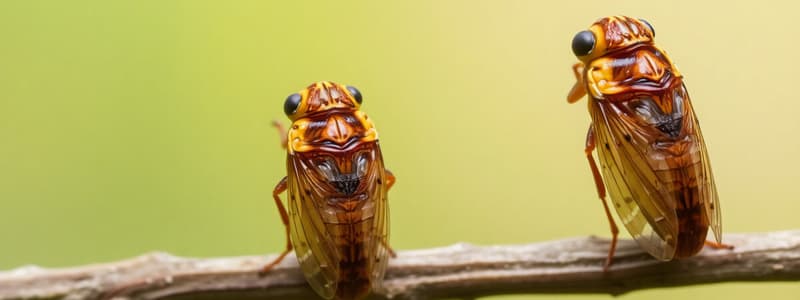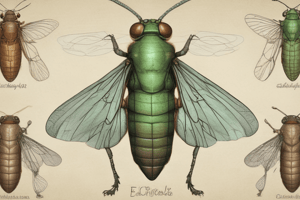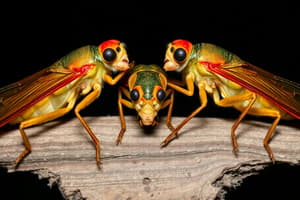Podcast
Questions and Answers
Why do researchers believe periodical cicadas emerge after prime number intervals like 13 or 17 years?
Why do researchers believe periodical cicadas emerge after prime number intervals like 13 or 17 years?
- The emergence of cicadas at prime number intervals is a random occurrence with no evolutionary advantage.
- Prime number cycles ensure that the cicadas emerge during years with the most favorable weather conditions for reproduction.
- Cicadas have evolved to emerge at prime number intervals to avoid competition with other insect species that emerge at even-numbered intervals.
- Predators find it difficult to synchronize their lifecycles to prime number intervals, preventing them from becoming dependent on cicadas as a food source. (correct)
If a hypothetical predator had a four-year lifecycle, why would cicadas emerging every 16 years be more vulnerable compared to emerging every 17 years?
If a hypothetical predator had a four-year lifecycle, why would cicadas emerging every 16 years be more vulnerable compared to emerging every 17 years?
- A 16-year emergence exposes cicadas to colder temperatures, increasing their mortality rate compared to a 17-year cycle.
- The predator's lifecycle would align every fourth cicada emergence, creating predictable feeding opportunities and potentially decimating the cicada population. (correct)
- Predators are more likely to evolve resistance to the defenses of cicadas that emerge every 17 years.
- A 17-year emergence requires cicadas to expend more energy, resulting in a lower reproductive rate compared to a 16-year cycle.
Why might the simultaneous emergence of Brood XIX and Brood XIII present a unique ecological opportunity for cicadas?
Why might the simultaneous emergence of Brood XIX and Brood XIII present a unique ecological opportunity for cicadas?
- The combined biomass of the two broods will overwhelm predators, ensuring a higher survival rate for both broods.
- The increased competition for resources following the emergence will drive natural selection, leading to the evolution of stronger cicada species.
- The convergence of different cicada populations could enhance genetic diversity, which will improve the cicadas adaptation to environmental changes. (correct)
- The overlap in emergence times might facilitate cross-brood mating, potentially creating hybrid cicadas with enhanced survival traits.
In what specific way do female cicadas cause damage to young trees when laying eggs?
In what specific way do female cicadas cause damage to young trees when laying eggs?
How does the rarity of the simultaneous emergence of Brood XIX and Brood XIII impact the predictability of ecological interactions?
How does the rarity of the simultaneous emergence of Brood XIX and Brood XIII impact the predictability of ecological interactions?
What is the most significant reason why the emergence of periodical cicadas is considered a nuisance?
What is the most significant reason why the emergence of periodical cicadas is considered a nuisance?
Assuming climate change alters the timing of tree budding, how might this affect periodical cicada survival, given their life cycle is intimately linked to tree roots?
Assuming climate change alters the timing of tree budding, how might this affect periodical cicada survival, given their life cycle is intimately linked to tree roots?
Considering the limited geographical overlap between Brood XIX and Brood XIII, what evolutionary advantage might there be for the two broods to maintain separate, yet synchronized, emergence cycles?
Considering the limited geographical overlap between Brood XIX and Brood XIII, what evolutionary advantage might there be for the two broods to maintain separate, yet synchronized, emergence cycles?
Flashcards
Rare Cicada Event
Rare Cicada Event
Cicadas emerging together from two different broods.
Brood XIX
Brood XIX
Brood emerging every 13 years.
Brood XIII
Brood XIII
Brood emerging every 17 years.
Last Dual Emergence
Last Dual Emergence
Signup and view all the flashcards
Cicada Diet
Cicada Diet
Signup and view all the flashcards
Prime Number Advantage
Prime Number Advantage
Signup and view all the flashcards
Cicada Impact
Cicada Impact
Signup and view all the flashcards
Cicada Decibels
Cicada Decibels
Signup and view all the flashcards
Study Notes
- Trillions of cicadas are expected to arrive in sixteen US states, from Maryland to Oklahoma and Illinois to Alabama.
- What makes this event rare is that two broods are emerging at the same time.
- Brood XIX, made up of four species that surfaces every 13 years, is emerging with Brood XIII, consisting of three species that appears every 17 years.
- This last happened 221 years ago, in 1803, and won't happen again until 2245.
- The insects have already begun to emerge in some areas.
- Their numbers are expected to peak for a two-to-three-week period starting mid-May.
- The two broods will come close in many states, but overlap only in Illinois and Iowa.
What are periodical cicadas?
- Periodical cicadas spend most of their lives underground, where they feed off sap from tree roots.
- The black, shrimp-sized bugs with red, beady eyes emerge every 13 or 17 years to reproduce and die soon after.
Why do cicadas come out every 13 or 17 years?
- Researchers believe that if the insects appeared after an even number of years, like 12 or 16, they would become predictable prey for predators with 2, 4, and 8-year lifespans.
- Since 13 and 17 are prime numbers, any predator dependent on the cicadas must match those lifespans.
Are cicadas dangerous?
- Cicadas are harmless to humans.
- Their swarms can be daunting and a nuisance as they seem to appear everywhere.
- The loud, high-pitched drone of male cicadas, which reaches 90 decibels as they try to attract females, can be extremely annoying.
- The insects can cause significant damage to young trees.
- Female cicadas seek out slender twigs or vines to lay their eggs.
- The incisions they make to deposit their eggs often sever the food supply, causing the branch to wilt.
- Mature trees can withstand this damage, but young fruit or nursery trees get stunted or killed.
- Experts suggest covering young trees with nets during the cicada onslaught.
- The adult cicadas die soon after the eggs are laid.
- Their bodies provide a rare feast for animals and nitrogen for growing trees.
- The eggs hatch in 4-6 weeks, and a new generation of cicadas burrows into the soil to live underground for the next 13 or 17 years.
Studying That Suits You
Use AI to generate personalized quizzes and flashcards to suit your learning preferences.





